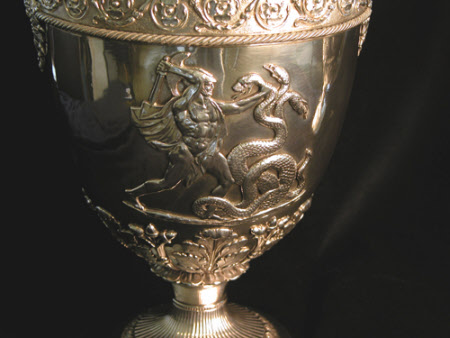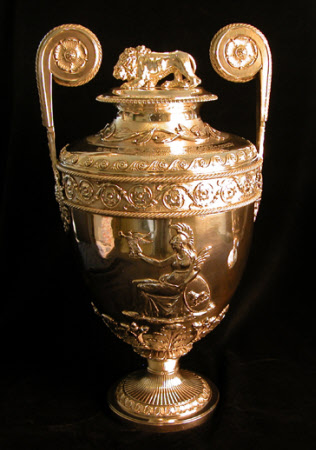Patriotic Fund Vase
Benjamin Smith
Date
1807 - 1809
Materials
Silver, sterling
Measurements
39 x 21.7 x 20 cm; Weight 3610 g
Place of origin
London
Order this imageCollection
Anglesey Abbey, Cambridgeshire
NT 516501
Summary
A Patriotic Fund vase, silver (sterling), mark of Benjamin Smith, for Rundell, Bridge & Rundell, London, 1807/9. Of Greek volute krater shape, the vase is formed of four parts, a two-handled cup, collar, cover and finial. The body of the cup is raised. It stands on a cast circular foot decorated with a narrow border of water leaves round a wide band of fluting, which supports a short stem, with an everted cast border of water leaves. The lower sides of the cup’s body are applied with cast and chased acanthus leaves alternating with sprigs of acorns. Applied above are large cast and chased figures representing Britannia and Hercules. The seated Britannia’s extended right hand supports the winged figure of Victory holding aloft a crown of laurel leaves; her left arm holds a sheaf of palm leaves and rests on her shield, which is charged with the British lion. On the opposite side a cloaked Hercules is depicted slaying the triple-headed Hydra. Beneath the rim of the vase two applied hawser-laid (right twisted) ropework borders sit either side of an embossed and chased frieze of quatrefoils and meandering scrolling foliage on a matted ground. Rising vertically from the sides of the vase are two cast handles, rectangular in cross section and applied with a rope border; the top scrolls round a Tudor rose patera, whilst the base is attached to the body with a daisy-like patera partially surrounded by a ring of oak leaves and acorns. The detachable collar is raised and applied with a narrow flange. Its slightly domed sides are applied with a border of scrolling volutes, and another of leaves and berries on a matted ground, and at the everted lip of the wide spool-shaped top is a border of gadroons. The flat cover is raised and applied with a narrow flange. The large cast finial, in the form of a finely modelled lion passant, is secured with one nut. The second screw has broken off the lion’s paw, and the nut is missing, so they have been replaced by a base metal screw screwed into the lion’s paw. The collar of the vase is inscribed: ‘From the PATRIOTIC FUND AT LLOYD’S/ TO THE HONORABLE ALEXANDER COCHRANE, REAR ADMIRAL OF THE WHITE/ FOR HIS NOBLE SUPPORT IN THE COMPLEAT VICTORY EFFECTED BY HIS MAJESTY’S FLEET/ IN AS SHORT A PERIOD AS THE NAVAL ANNALS OF GREAT BRITAIN EVER RECORDED/ OVER A SQUADRON OF FRENCH SHIPS OF THE LINE, OFF S DOMINCO/ On the 5th February 1806’. Heraldry: None Recipient: Rear Admiral the Hon. Alexander Cochrane Hallmarks: Fully marked on the on the foot ring: ‘BS’ (Benjamin Smith*), lion passant (sterling), leopard’s head (London), ‘N’ (1808/9), and monarch’s head (duty mark); part marked on the flange of the vase’s collar: ‘BS’, lion passant, and ‘N’; on the flange of the cover: ‘lion passant, and ‘M’ 1807/8); and on the stomach of the lion: monarch’s head, lion passant, and ‘BS’. (The nut is not hallmarked.) *Arthur Grimwade: London Goldsmiths 1697-1837, 1990, p 28, no 229 Scratch weight: None Other marks: To identify the four parts of the vase they are all stamped with the number ‘3’.
Full description
NOTES ON PATRIOTIC FUND VASES On the same day in 1798 as the London Gazette announced Nelson’s victory over the French fleet at the Battle of the Nile, the Morning Chronicle carried an advertisement from Lloyd’s Coffee House announcing: ‘A subscription for the relief of the Widows and Children of the Brave Men who fell in the service of the KING and COUNTRY and for such as have been wounded in the glorious victory obtained by the British Fleet, under command of Rear Admiral Sir Horatio Nelson’. [1] This was not the first public subscription of its kind – numerous appeals had been run throughout the 18th century. Just five years’ later, in May 1803, after little more than a year’s peace with France, hostilities were renewed. In July Lloyd’s of London met ‘for the purpose of setting on foot a general subscription, on an extended scale, for the encouragement and relief of those who may be engaged in the defence of the country and who may suffer in the common cause.’ A committee, of what came to be known as the Patriotic Fund, was formed, with their resolutions published in a leaflet and newspapers, and funds sought. By August The Times was able to report that: ‘The Committee acknowledge with true patriotic pride that the Subscription exceeds any that has been recorded in the Annals of our History’. A competition was held to find suitable designs for the awards. The top prize of fifty guineas was won by the architect and artist, John Shaw (1776-1832) for his design for a vase, and by the painter, Edward Edwards (1738-1806) for his drawings for a medal. However, the committee wrote that the two winning designs were nearly the same, so both could serve ‘as the principal ornaments’ for both vase and medal. Anthony Twist suggests that this wording implies that Edwards’ design played some part in the final decoration of the vase. It is presumed that the drawings were passed to Rundell & Bridge, the crown jewellers, who were chosen to make the Patriotic Fund vases. They were an obvious choice. They were patronised by the chairman of the Patriotic Fund, John Angerstein (1735-1823), a Lloyds underwriter and businessman, the Corporation of London, Admiral Lord Nelson, and the British royal family. Rundell’s were in their ascendancy. ‘At its zenith no other firm could rival their business in the size of stock of silver, jewellery, snuffboxes or other luxury goods, nor in the immense capital they had accumulated.’ [2] They were also masters of the fashionable neo-classical style typified by the krater shape of the Patriotic Fund vase. They invited John Flaxman (1755-1826), the renowned sculptor and illustrator, to modify the winning design(s). Sadly, the drawings do not survive and without them we are unable tell how much Flaxman altered Shaw’s original design or how Edwards’ drawing of the medal may have influenced the shape or decoration of the vase. By 1815 the Patriotic Fund had raised £543,000, most of which had already been distributed to aid the injured and the families of those killed in battle. However, Patriotic Fund vases were only presented between 1804 and 1809. In total 73 vases were awarded, although a few more may have been produced. (There is one in the Victoria & Albert Museum which was never inscribed, so may have been surplus to requirements.) The first vase to be presented was valued at £30, and is not krater shaped, probably because its creation predates the production of Flaxman’s vases. Most of the awards were for £100 vases, and all are of the same krater shape but with minor variations. The £300 and £500 vases are of the same design, but sometimes larger and on a stand, such as those awarded after Trafalgar to Lady Nelson, on the death of her husband, and to Vice-Admiral Lord Collingwood; both of which are now in the Royal Collection. The Admiralty and the War Office recommended the servicemen for deeds of outstanding leadership or marks of bravery. Their recommendations were then considered by the committee managing the fund. The names of the recipients were recorded, along with the date when the committee voted that they should receive the award, its value, the inscription, the final cost, and the date of delivery. Thirteen vases were awarded for the defeat of the French Fleet off St Domingo; one of £400, two of £300 and ten of £100. Admiral Sir Alexander Cochrane was selected to receive one of the £300 vases on 25 March 1806, but it was not delivered until November 1810. [3] We do not know the reason for the delay between the award and delivery of the vase, but gaps of three to five, or even six, years were not uncommon, perhaps because the recipient was abroad or still deciding between a sword or vase. What is curious is that this vase is of similar design, weight and dimensions to the two £100 vases at Anglesey Abbey (see 516454 and 51652). Rear-Admiral Sir Thomas Louis received the only other £300 vase awarded for the defeat of the French at St Domingo. His vase, now at Balliol College Oxford, has a stand. It is therefore presumed that the stand for Cochrane’s vase was lost. The Admiral’s illegitimate nephew, Capt. ND Cochrane, who commanded the Kingfisher at the battle of St Domingo was awarded a £100 vase on the same day as his uncle. [1] Anthony Twist: Towards The Patriotic Fund; The Journal of The Silver Society, 2010, No 26, pp 75-95 [2] Christopher Hartop: Royal Goldsmiths The Art of Rundell & Bridge 1797-1843, 2005, p 21 [3] Leslie Southwick: The Silver Vases Awarded to the Patriotic Fund: The Journal of The Silver Society Winter 1990, pp 27-49 NOTES ON ADMIRAL SIR ALEXANDER COCHRANE KCB Alexander Forester Inglis Cochrane (1758-1832) was the sixth son of the 8th Earl of Dundonald and his second wife, Jane Stuart. He joined the Royal Navy as a boy and served with British naval forces in North America, South America, the East Indies, Egypt and the Caribbean. He commanded the Northumberland at the Battle of San Domingo where his prompt action to swing his ship between the French cannons and the British flagship saved the flagship. Although the fire was so close and heavy that several shots passed straight through Cochrane’s ship into the British flagship. Twenty-one of Northumberland’s sailors were killed and seventy-nine wounded, with Cochrane narrowly escaping death when his hat was carried off his head by a huge splinter. To honour his part in the victory he was appointed KCB and received the thanks of both Houses of Parliament. During the blockading of the United States to prevent their trading with France, Cochrane, then a vice-admiral, served as commander-in-chief of both the North American Station in Bermuda and the West Indies Station in Jamaica. Perhaps the best remembered of Cochrane’s many actions at that time is his command of the landing of the British troops who were responsible for the burning of Washington in 1814. In 1821 Cochrane was appointed Commander-in-Chief of Plymouth, one of the most senior positions in the Royal Navy, a post he held until his retirement in 1824. He died aged 73 whilst visiting his daughter in Paris.
Provenance
Admiral Sir Alexander Inglis Cochrane KGCB (1758-1832) (Urban) Huttleston Rogers Broughton, 1st Lord Fairhaven (1896-1966); bequeathed by Lord Fairhaven to the National Trust along with the house and the rest of the contents. National Trust.
Credit line
Anglesey Abbey, the Fairhaven Collection (National Trust)
Makers and roles
Benjamin Smith, goldsmith Rundell, Bridge and Rundell, goldsmith





